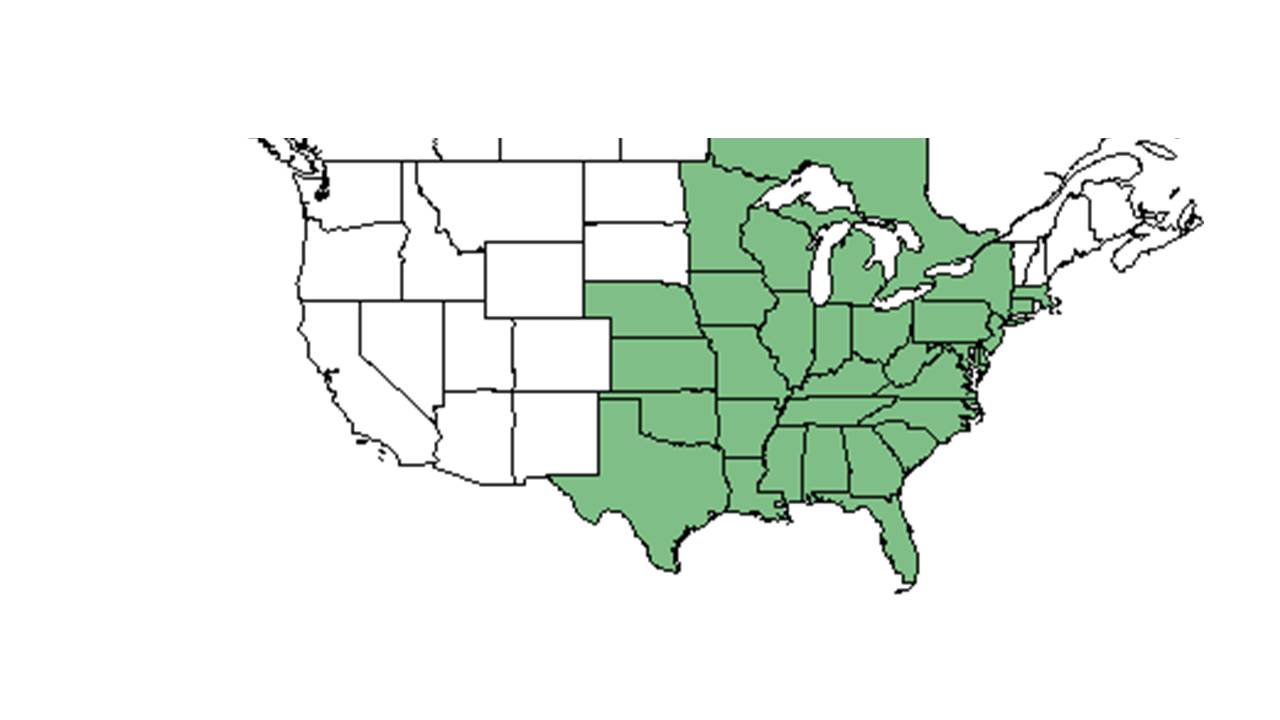Difference between revisions of "Eupatorium altissimum"
(→Pollination and use by animals) |
|||
| (4 intermediate revisions by 2 users not shown) | |||
| Line 18: | Line 18: | ||
}} | }} | ||
| − | Common name: | + | Common name: tall thoroughwort |
==Taxonomic notes== | ==Taxonomic notes== | ||
| − | Synonyms: none.<ref name= | + | Synonyms: none.<ref name=weakley>Weakley, A.S. 2020. Flora of the Southeastern United States. Edition of 20 October 2020. University of North Carolina at Chapel Hill, Chapel Hill, North Carolina.</ref> |
| − | Varieties: none | + | Varieties: none<ref name=weakley/> |
==Description== | ==Description== | ||
| Line 29: | Line 29: | ||
==Distribution== | ==Distribution== | ||
| − | It is seen as far noth as CT; stretches south to Florida, and to Texas. <ref name= | + | It is seen as far noth as CT; stretches south to Florida, and to Texas.<ref name=weakley/> It is mostly seen in the midwest on limestone substrates, but uncommon east of the mountains.<ref name=weakley/> |
| + | |||
==Ecology== | ==Ecology== | ||
===Habitat=== <!--Natural communities, human disturbed habitats, topography, hydrology, soils, light, fire regime requirements for removal of competition, etc.--> | ===Habitat=== <!--Natural communities, human disturbed habitats, topography, hydrology, soils, light, fire regime requirements for removal of competition, etc.--> | ||
| − | It is found in woodlands, old fields, woodland edges, and openings over mafic rocks or calcareous rocks. <ref name= | + | It is found in woodlands, old fields, woodland edges, and openings over mafic rocks or calcareous rocks.<ref name=weakley/> It is also found in roadside ditches. <ref name="FSU Herbarium"/> |
| + | |||
===Phenology=== <!--Timing off flowering, fruiting, seed dispersal, and environmental triggers. Cite PanFlora website if appropriate: http://www.gilnelson.com/PanFlora/ --> | ===Phenology=== <!--Timing off flowering, fruiting, seed dispersal, and environmental triggers. Cite PanFlora website if appropriate: http://www.gilnelson.com/PanFlora/ --> | ||
''E. altissimum'' has been observed flowering in July and September.<ref>Nelson, G. [http://www.gilnelson.com/ PanFlora]: Plant data for the eastern United States with emphasis on the Southeastern Coastal Plains, Florida, and the Florida Panhandle. www.gilnelson.com/PanFlora/ Accessed: 9 DEC 2016</ref><ref name="FSU Herbarium">Florida State University Robert K. Godfrey Herbarium database. URL: [http://herbarium.bio.fsu.edu http://herbarium.bio.fsu.edu]. Last accessed: June 2014. Collectors: R. Kral. States and Counties: Florida: Liberty.</ref> Flowers from August to November according to Weakley (2015). | ''E. altissimum'' has been observed flowering in July and September.<ref>Nelson, G. [http://www.gilnelson.com/ PanFlora]: Plant data for the eastern United States with emphasis on the Southeastern Coastal Plains, Florida, and the Florida Panhandle. www.gilnelson.com/PanFlora/ Accessed: 9 DEC 2016</ref><ref name="FSU Herbarium">Florida State University Robert K. Godfrey Herbarium database. URL: [http://herbarium.bio.fsu.edu http://herbarium.bio.fsu.edu]. Last accessed: June 2014. Collectors: R. Kral. States and Counties: Florida: Liberty.</ref> Flowers from August to November according to Weakley (2015). | ||
| Line 38: | Line 40: | ||
<!--===Seed bank and germination===--> | <!--===Seed bank and germination===--> | ||
<!--===Fire ecology===--> <!--Fire tolerance, fire dependence, adaptive fire responses--> | <!--===Fire ecology===--> <!--Fire tolerance, fire dependence, adaptive fire responses--> | ||
| − | ===Pollination | + | ===Pollination=== |
''Eupatorium altissimum'' has been observed to host plasterer bees such as ''Hylaeus mesillae'' (family Colletidae).<ref>Discoverlife.org [https://www.discoverlife.org/20/q?search=Bidens+albaDiscoverlife.org|Discoverlife.org]</ref> | ''Eupatorium altissimum'' has been observed to host plasterer bees such as ''Hylaeus mesillae'' (family Colletidae).<ref>Discoverlife.org [https://www.discoverlife.org/20/q?search=Bidens+albaDiscoverlife.org|Discoverlife.org]</ref> | ||
| + | <!--===Herbivory and toxicology===--> | ||
<!--===Diseases and parasites===--> | <!--===Diseases and parasites===--> | ||
Latest revision as of 14:41, 26 May 2023
| Eupatorium altissimum | |
|---|---|
Error creating thumbnail: Unable to save thumbnail to destination
| |
| Photo by Jennifer Anderson, hosted by the USDA-NRCS PLANTS Database | |
| Scientific classification | |
| Kingdom: | Plantae |
| Division: | Magnoliophyta - Flowering plants |
| Class: | Magnoliopsida – Dicotyledons |
| Order: | Asterales |
| Family: | Asteraceae ⁄ Compositae |
| Genus: | Eupatorium |
| Species: | E. altissimum |
| Binomial name | |
| Eupatorium altissimum L. | |

| |
| Natural range of Eupatorium altissimum from USDA NRCS Plants Database. | |
Common name: tall thoroughwort
Contents
Taxonomic notes
Synonyms: none.[1]
Varieties: none[1]
Description
A description of Eupatorium altissimum is provided in The Flora of North America.
Distribution
It is seen as far noth as CT; stretches south to Florida, and to Texas.[1] It is mostly seen in the midwest on limestone substrates, but uncommon east of the mountains.[1]
Ecology
Habitat
It is found in woodlands, old fields, woodland edges, and openings over mafic rocks or calcareous rocks.[1] It is also found in roadside ditches. [2]
Phenology
E. altissimum has been observed flowering in July and September.[3][2] Flowers from August to November according to Weakley (2015).
Pollination
Eupatorium altissimum has been observed to host plasterer bees such as Hylaeus mesillae (family Colletidae).[4]
Conservation, cultivation, and restoration
Cultural use
Photo Gallery
References and notes
- ↑ 1.0 1.1 1.2 1.3 1.4 Weakley, A.S. 2020. Flora of the Southeastern United States. Edition of 20 October 2020. University of North Carolina at Chapel Hill, Chapel Hill, North Carolina.
- ↑ 2.0 2.1 Florida State University Robert K. Godfrey Herbarium database. URL: http://herbarium.bio.fsu.edu. Last accessed: June 2014. Collectors: R. Kral. States and Counties: Florida: Liberty.
- ↑ Nelson, G. PanFlora: Plant data for the eastern United States with emphasis on the Southeastern Coastal Plains, Florida, and the Florida Panhandle. www.gilnelson.com/PanFlora/ Accessed: 9 DEC 2016
- ↑ Discoverlife.org [1]